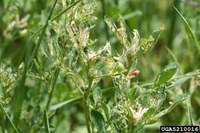Now is the time to scout for alfalfa weevil
(Click the image below to view a high-resolution image that can be downloaded)
Alfalfa weevil is the first pest to hit alfalfa fields and is an annual occurrence as they overwinter as adults. Fortunately, the alfalfa weevil only produces one generation per year and once first harvest passes, little damage from alfalfa weevil will occur the remainder of the year.
“It is amazing how insect pests can zero in on a field and seem to come out of nowhere,” says James Rogers, NDSU Extension forage crops production specialist at the North Central Research Extension Center in Minot. “Several years ago, I planted a field to alfalfa that had not been in alfalfa production for several years, and it was the only field of alfalfa for several miles. Sure enough, alfalfa weevils found it and control measures were called for.”
Alfalfa weevil requires heat units for egg hatch to begin and growth development to occur. The heaviest damage to alfalfa is due to larvae feeding at the third and fourth instar stages of development when the larvae have reached maturity. Heavy damage to alfalfa will result in the leaves of plants having a frosted appearance with numerous holes from larvae feeding.
The best practice for alfalfa weevil management is scouting, says Rogers. Scouting should take place now through the first cutting.
To scout an alfalfa field:
- Walk the field in an “M” pattern and stop at five locations along the route.
- At each stop, collect six alfalfa stems and shake the stems into a bucket.
- Measure the height of the alfalfa and notice any flowering or bud development.
- Cover the entire field over the course of your route. At the end of the route, you will have collected thirty stems.
- Record the average plant height and count the total number of larvae found and average number per stem.
To determine the economic threshold for control using a pesticide, it is best to determine the market value of the hay and the cost of control. Alfalfa crop market value is the major driver in determining the economic threshold for control.
In general, as crop value increases, the number of larvae it takes to justify control decreases. This is modified by plant height (maturity) and control ($/acre) costs.
The NDSU Extension publication “Integrated Pest Management of Alfalfa Weevil in North Dakota” contains tables on economic thresholds for alfalfa weevil based on plant height, crop value and control costs. Find the publication at ndsu.ag/alfalfaweevil.
If scouting reveals the presence of the alfalfa weevil, an insecticide application is not the only option. There are at least three approaches that can be taken to deal with the problem, two of which avoid insecticide use.
The first is cultural; harvest early. If alfalfa has reached the 50% bud stage and alfalfa weevil numbers have reached the economic threshold, then harvesting can be very effective and avoid a pesticide application. Try to bale as soon as possible following harvest, as weevils can shelter under windrows, recommends Rogers.
Second, while scouting, look for larvae that are off colored from a lime green color. This could be an indication of biological control from a fungal pathogen or parasitic wasp. This activity may be enough to keep alfalfa weevils below economic threshold. If this type of activity is noted, keep scouting to determine if alfalfa numbers are continuing to rise or are declining.
Third is a foliar insecticide. Think of this as being a last resort if an early harvest is not an option. There are many options for insecticide control, but caution is advised due to potential alfalfa weevil resistance, pre-harvest and pre-grazing intervals, and pollinator safety. Alfalfa is a huge attractant to bees and other pollinators. If an insecticide must be used, follow pollinator safety.
Do not spray plants in bloom and only apply insecticides early in the morning or late in the evening when bees are not active, cautions Rogers. North Dakota is the number one honey-producing state in the U.S. If hives are located close to an area where an insecticide application will be made, work with the beekeeper to avoid potential damage. Always read and follow label directions when using all pesticides.
NDSU Agriculture Communication – June 7, 2023
Source: James Rogers, 701-857-7682, james.rogers.1@ndsu.edu
Editor: Kelli Anderson, 701-231-7881, kelli.c.anderson@ndsu.edu


